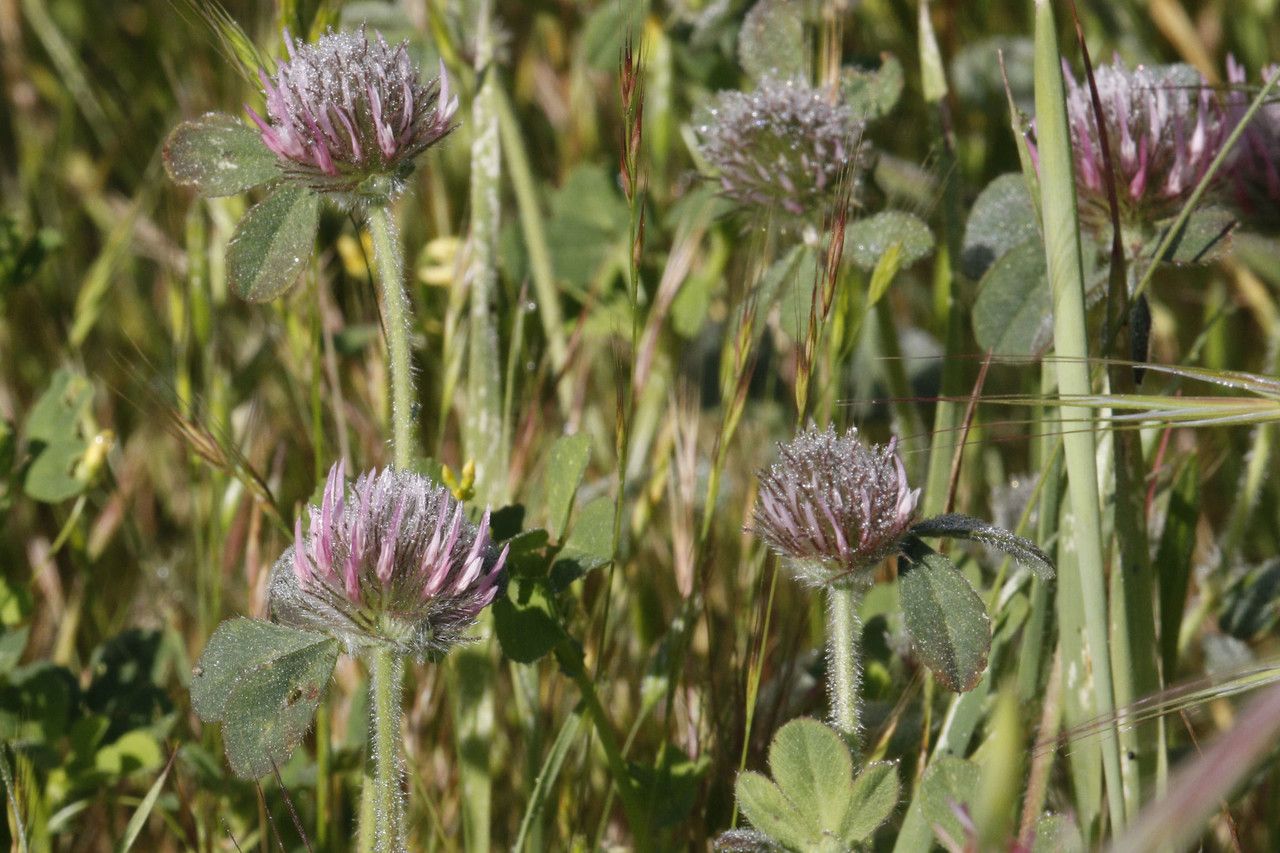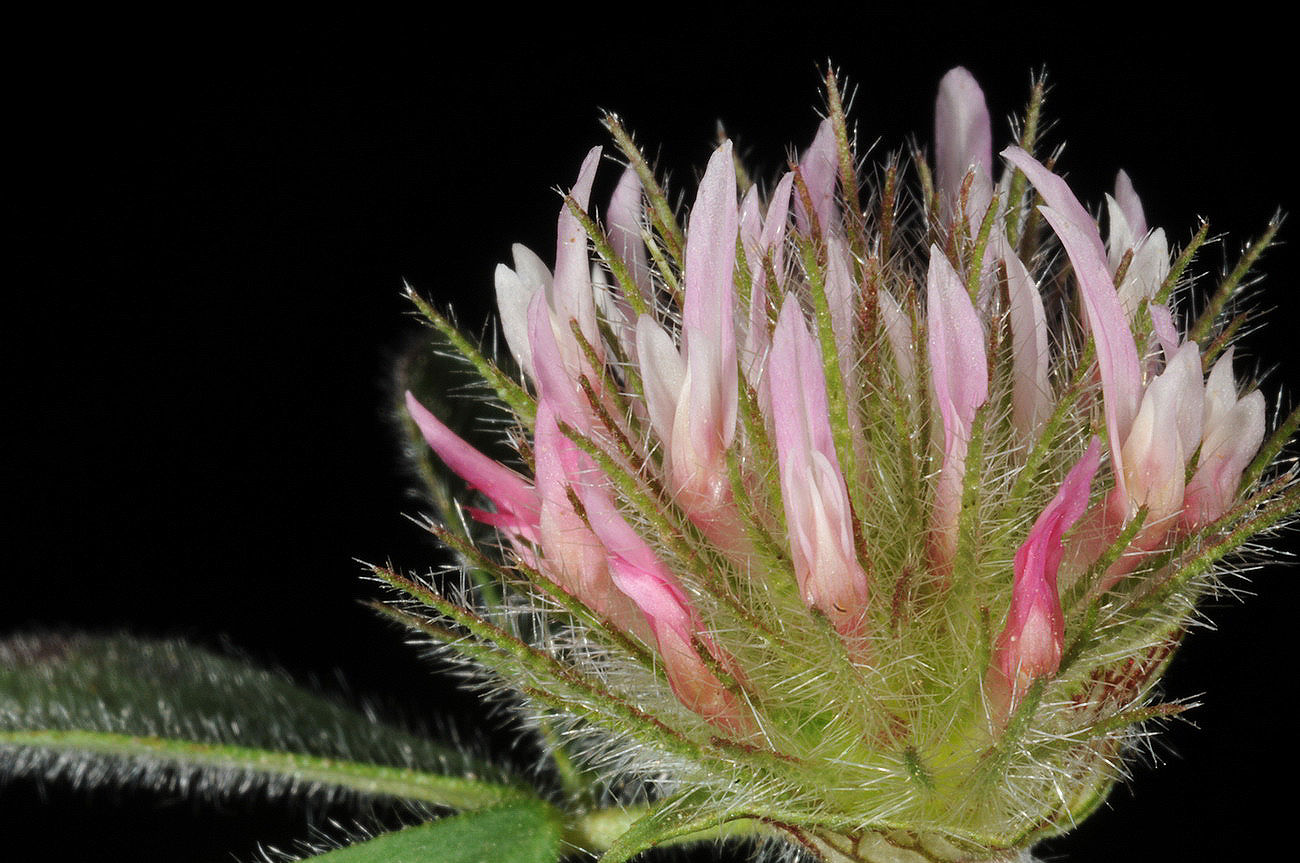Rose Clover
trifolium hirtum
Also known as: ["Rose Clover","Hairy Clover"]
Overview
A perennial clover species with rose-colored flowers and hairy stems and leaves.
Benefits & Perks
["long-flowering","wildlife attractant (bees, butterflies, birds)","drought tolerant","fragrant flowers"]
Botanical Classification
| Phylum: | Magnoliophyta |
| Class: | Magnoliopsida |
| Order: | Fabales |
| Family: | Fabaceae |
| Genus: | Trifolium |
| Botanical Name: | Trifolium hirtum |
Plant Characteristics
Basic Information
- Category: Flowers
- Suitable Location: garden bed or container in a sunny spot
- Suitable For:
- Is Weed: No
- Allergenicity: low
Environmental Needs
- Climate: {"temperatureRange":"5–30°C"}
- Hardiness: {"zones":"8–10"}
- Misting: rarely required, only if ambient humidity is very low
- Drainage: Fast-draining to prevent waterlogging.
- Soil Type: Well-draining, loamy soil with added organic matter; can use a cactus or succulent mix amended with compost.
Maintenance Level
- Maintenance Level: low
- Toughness Level: moderate
- Pruning Frequency: After flowering or every 2–3 months to maintain shape and vigor.
- Pruning Intensity: Moderate; remove up to one-third of the plant if overgrown, but avoid heavy pruning during flowering
Care Details
Ideal Sunlight Coverage:
Bright indirect light for 6–8 hours daily; can tolerate some direct morning sun but avoid harsh afternoon sun.
Sunlight Tolerance Tips:
Acclimate plants gradually to direct sunlight to prevent scorching; place indoors near a south or west-facing window with sheer curtains; for outdoor placement, provide partial shade during peak sun hours.
Care Requirements
Care Difficulty
easymoderate
Sunlight
full sun to partial shade
Rotate plant weekly for even growth; use sheer curtains to filter intense light; avoid placing near heat sources that can intensify light exposure.
Watering
every 7–10 days during active growth, reduce in winter
Water thoroughly but infrequently; ensure soil dries between waterings; avoid overhead watering to prevent fungal issues.
Soil
well-draining, sandy loam with moderate organic matter
pH: Slightly acidic to neutral (pH 6.0–7.0).
Use a pot with drainage holes; avoid heavy clay soils; test soil pH periodically.
Temperature
Prefers moderate temperatures between 60–75°F (15–24°C); can tolerate cooler temperatures but avoid prolonged exposure below 50°F (10°C).
Avoid placing near drafty windows or doors; maintain consistent room temperature; monitor plant response to seasonal changes.
Fertilizing
every 4–6 weeks during spring and summer
Always water before fertilizing to prevent root burn; flush soil occasionally to prevent salt buildup; choose a fertilizer with equal NPK ratios.
Propagation
Methods
Stem cuttings or division; stem cuttings are more common for home growers.
Step-by-Step Propagation Guide
- Take a 4–6 inch stem cutting just below a node.
- Remove lower leaves.
- Dip in rooting hormone.
- Plant in moist propagation medium.
- Cover with a plastic bag to maintain humidity.
Best Time: Spring or early summer when the plant is actively growing.
Environment
Warm, humid environment with indirect light; maintain temperatures around 70–75°F (21–24°C) and high humidity.
Medium
Well-draining potting mix with perlite or sand; can also use a mix of peat and sand.
Hormone
Rooting hormone is recommended to improve success rates.
Timeline
Roots typically develop in 3–6 weeks; new growth may appear in 2–3 months.
Tools Needed
Sharp pruners, rooting hormone, small pots, plastic bags, misting bottle.
Quick Tips
Use clean tools to prevent disease; keep soil consistently moist but not waterlogged; provide bottom heat if possible to speed up rooting.
Pruning & Repotting
Pruning Guide
Method
Pinch back tips to encourage branching; deadhead spent flowers by cutting just above a leaf node.
Pruning Plan
Prune to maintain shape, encourage bushier growth, and remove spent flowers to promote reblooming.
Tools
Sharp, clean pruners or scissors; gloves.
Checklist
Use clean tools; prune after flowering; remove dead or damaged growth; shape as needed.
Repotting Guide
Best Season
Spring, before the active growing season begins.
Pot Size
Choose a pot one size larger (1–2 inches wider in diameter) than the current one.
Method
Remove plant gently; trim any circling roots; place in a new pot with fresh soil; water thoroughly after repotting.
Suggestions
Repot every 2–3 years or when roots outgrow the pot; beneficial for refreshing soil and providing more space.
Checklist
Select appropriate pot size; prepare fresh soil mix; handle roots carefully; water after repotting; place in appropriate light.
Advanced Care Tips
Watering Mastery
Watering Checklist
Check soil moisture before watering; water deeply at the base; ensure proper drainage; adjust frequency based on season and weather.
How to Apply Water Properly
Water at the base of the plant, ensuring moisture reaches the root zone; water early in the day to minimize evaporation and fungal growth; allow excess water to drain away to prevent waterlogging.
Watering Schedule Tips
Water deeply once the top inch of soil feels dry; reduce frequency in winter to prevent root rot.
Soil Improvement
Add perlite or coarse sand for drainage; incorporate compost for fertility; ensure soil is loose and airy.
Temperature Stress Management
Signs of Temperature Issues
Chlorosis (yellowing leaves), wilting, bud drop, or stunted growth; leaf scorch or browning edges in excessive heat.
Cold Stress
Low temperatures can slow growth and cause leaf discoloration; prolonged cold may lead to root damage or death.
Solution: Move plants indoors or to a protected area during cold spells; provide a layer of mulch to insulate roots; use a space heater or heat mat for extreme cold.
Hot Stress
Excessive heat can cause wilting, leaf scorch, and reduced flowering; may lead to dehydration and nutrient deficiencies.
Solution: Provide shade during peak sun hours; increase humidity with misting or a humidifier; water more frequently but ensure proper drainage.
Fertilizing Guide
Fertilizing Checklist
Use diluted fertilizer; apply during active growth; avoid winter feeding; flush soil periodically.
Fertilizing Method
Use a balanced liquid fertilizer diluted to half strength every 4–6 weeks during the growing season (spring and summer); avoid fertilizing in winter.
Common Problems & Solutions
Toxicity Warning
Cats
Non-toxicTrifolium hirtum is not considered toxic to cats. There are no reported cases of toxicity in felines after ingestion or contact with this plant.
⚡ Toxic If:
Generally non-toxic
Dogs
Non-toxicTrifolium hirtum is not considered toxic to dogs. There are no reported cases of toxicity in canines after ingestion or contact with this plant.
⚡ Toxic If:
Generally non-toxic
Humans
Non-toxicTrifolium hirtum, commonly known as rose clover, is not considered toxic to humans under normal circumstances. It is often used as forage for livestock and has no known significant toxic effects on humans.
⚡ Toxic If:
Generally non-toxic
Frequently Asked Questions
Q: Is Trifolium hirtum toxic to pets?
A: No, it is non-toxic to dogs and cats.
Q: Does Rose Clover attract wildlife?
A: Yes, it attracts bees, butterflies, and birds.
Q: How often should Rose Clover be watered?
A: It is drought-tolerant and requires minimal watering once established.
Quick Reference
| Family: | Fabaceae |
| Care: | easy |
| Light: | full sun to partial shade |
| Water: | every 7–10 days during activ |
Get Expert Care Tips
Download the Plantious app for personalized care reminders and plant identification!
Google Play App Store








